-
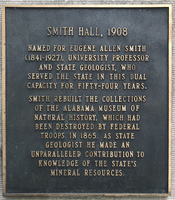 Smith Hall, 1908
Smith Hall, 1908 Named for Eugene Allen Smith (1841-1927), University Professor and State Geologist, who served the State in this dual capacity for fifty-four years.
Smith rebuilt the collections of the Alabama Museum of Natural History, which had been destroyed by Federal Troops in 1865. As State Geologist he made an unparalleled contribution to knowledge of the State's mineral resources.
-
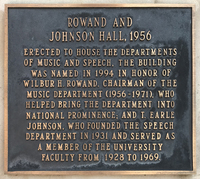 Rowand and Johnson Hall, 1956
Rowand and Johnson Hall, 1956 Erected to house the Departments of Music and Speech, the building was named in 1994 in honor of Wilbur. H. Rowand, Chairman of the Music Department (1956-1971), who helped bring the department into national prominence, and T. Early Johnson, who founded the Speech Department in 1931 and served as a member of the University Faculty from 1928 to 1969.
-
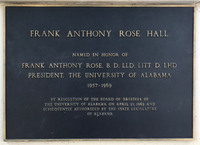 Rose Administration
Rose Administration Frank Anthony Rose Hall
Named in honor of
Frank Anthony Rose, B. D., LLD; Litt. D, LHD
President, The University of Alabama
1957-1969
By resolution of the Board of Trustees of The University of Alabama on April 21, 1969 and subsequently authorized by the state legislature of Alabama
-
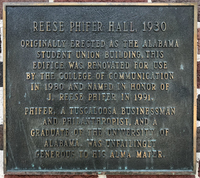 Reese Phifer Hall, 1930
Reese Phifer Hall, 1930 Originally erected as the Alabama Student Union building, this edifice was renovated for use by the College of Communication in 1980 and named in honor of J. Reese Phifer in 1991.
Phifer, a Tuscaloosa businessman and philanthropist, and a graduate of the University of Alabama, was unfailingly generous to his alma mater.
-
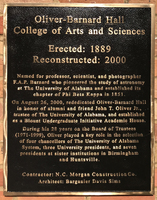 Oliver-Barnard Hall
Oliver-Barnard Hall College of Arts and Sciences
Erected: 1889
Reconstructed: 2000
Named for professor, scientist, and photographer F.A.P. Barnard who pioneered the study of astronomy at The University of Alabama and established its chapter of Phi Beta Kappa in 1851.
On August 26, 2000, rededicated Oliver-Barnard Hall in honor of alumni and friend John T. Oliver Jr., trustee of The University of Alabama, and established as a Blount Undergraduate Initiative Academic House.
During his 28 years on the Board of Trustees (1971-1999), Oliver played a key role in the selection of four chancellors of The University of Alabama System, three University presidents, and seven presidents at sister institutions in Birmingham and Huntsville.
Contractor: N.C. Morgan Construction Co.
Architect: Barganier Davis Sims
-
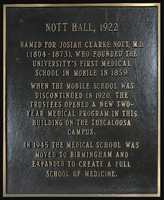 Nott Hall, 1922 [removed]
Nott Hall, 1922 [removed] Named for Josiah Clarke Nott, M.D. (1804-1873), who founded the University's first medical school in Mobile in 1859.
When the Mobile school was discontinued in 1920, the Trustees opened a new two-year medical program in this building on the Tuscaloosa campus.
In 1945 the Medical School was moved to Birmingham and expanded to create a full School of Medicine.
-
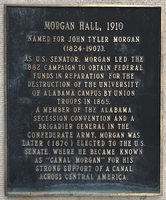 Morgan Hall, 1910 [removed]
Morgan Hall, 1910 [removed] Named for John Tyler Morgan (1824-1907).
As U.S. Senator, Morgan led the 1882 campaign to obtain federal funds in reparation for the destruction of the University of Alabama campus by Union Troops in 1865.
A member of the Alabama Secession Convention and a Brigadier General in the Confederate Army, Morgan was later (1876) elected to the U.S. Senate, where he became known as "Canal Morgan" for his strong support of a canal across Central America.
-
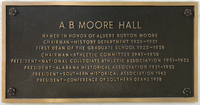 A.B. Moore Hall [removed]
A.B. Moore Hall [removed] Named in honor of Albert Burton Moore
Chairman - History Department 1923-1951
First Dean of the Graduate School 1925-1958
Chairman - Athletic Committee 1941-1958
President - National Collegiate Athletic Association 1951-1952 President - Alabama Historical Association 1951-1952
President - Southern Historical Association 1942
President - Conference of Southern Deans 1938
-
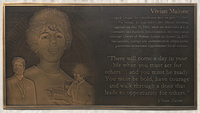 Vivian Malone
Vivian Malone stepped through the schoolhouse door on June 11, 1963. She became the University’s first African-American graduate on May 30, 1965, when she received a B.S. in Commerce and Business Administration. She received an Honorary Doctor of Humane Letters on August 12, 2000. Her sacrifice, courage and commitment to simple justice guaranteed educational opportunities for all students.
"There will come a day in your life when you must act for others… and you must be ready. You must be bold, have courage and walk through a door that leads to opportunity for others.” Vivian Malone
-
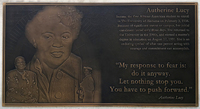 Autherine Lucy
Autherine Lucy became the first African-American student to enroll in The University of Alabama on February 3, 1956. Because of significant unrest on campus, her initial enrollment lasted only three days. She returned to the University in the 1980s, and earned a master’s degree in education on August 17, 1991. She is an enduring symbol of what one person acting with courage and commitment can accomplish.
“My response to fear is: do it anyway. Let nothing stop you. You have to push forward.” Autherine Lucy
-
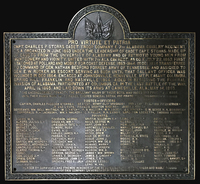 Storrs Cadet Troop [removed]
Storrs Cadet Troop [removed] Pro Virtute Et Patria
Capt. Charles P. Storrs cadet troop, Company F, 7th Alabama Cavalry Regiment, C.S.A.,organized in June 1863 under the leadership of Cadet Capt. Storrs, made up of cadets from The University of Alabama and of patriotic young men from Montgomery and vicinity; united with 7th Ala. Cav. Regt. as Co. F, July 22, 1863. First stationed at Pollard and Mobile for coast defense, 1863-1864; in Oct. 1864 transferred to command of Gen. Nathan Bedford Forrest, Army of Tennessee, and assigned to Gen. E. W. Rucker as escort, serving as such until that gallant officer was wounded in Dec. 1864; engaged at Johnsonville, Henryville, Mt. Pleasant, Columbia, Spring Hill, Franklin and Nashville, 1864; aided in resisting the federal invasion of Alabama; participated at Columbus, Ga., in the last battle of the war, April 16, 1865; and laid down its arms at Gainesville, Ala., May 14, 1865.
“The unconquerable tenacity, the brilliant valor of these boys, who faced and fought all odds, until their ranks were cut to pieces, excited general notice and praise.” – Jordan’s Campaigns of Forrest, 1868
Roster – Officers
Captain Charles Paddock Storrs+, 1st Lieut. Henry Clay Vaughan+, 2nd Lieut. Benjamin Fitzpatrick+
Jr. 2nd Lieuts. Francis Drayton Nabers+, James A. Craig+
Sergeants Wm. Bell Whiting+, W. D. Hatch+, R. B. Waller+, W. H. Locke+, J. G. Winter+, Q.M. Sergt. H. S. McGowen+
Corporals R. H. Jackson+, Wm. A. Walker+, C. P. Field+, R. H. Evins+, Napoleon Lockett+, Thomas Hudson
Privates
Adams, W. H.; Davidson, George; Griffin, Goodman G.+; Lowe, George J.; Smith, B.
Alford, Julius S.+; Douglas, Wm.+; Hails, George W.; McAdory, R. A.+; Smith, George
Anderson, L.; Driesbach, Tate R.+; Hart, John S.+; McMillan, J. D.+; Taylor, W. K.
Barnett, Joel; Elmore, Rush; Hartwell, Charles; Marks, Samuel B.+; Thorington, Jack
Bethea, A. Jack; Evins, A. J.; Hatch, Ben F.+; Metcalf, John; Trimble, W. Ross+
Bolling, T. C.; Farley, James H.+; Hatch, Drew; Miller, A. A.+; Tyson, A. P.+
Boyd, Joe J.; Farrar, H. K.; High, De Witt C.+; Mitchell, C. White; Underwood, J. B.
Brittan, Henry S.; Fletcher, Matt; Hogue, John J.; Moore, A. B.; Vaughan, Joseph L.
Caffey, Wm. Hooper+; Fletcher, Wm.; Hooper, Wm. De B.; Moore, W. J.; Vernon, James B.+
Campbell, Archibald+; Forniss, John A.; Howard, Mark+; Morrison, W. J.; Walker, W. T.
Cantalou, John R.+; Foster, Young H.+; Hudson, Joseph; Morrow, George M.; Ware, A. S.
Clarke, Thomas D.+; Goldthwaite, George+; Hudson, Wm. H.; Myers, Laurens O’B.+; Ware, J. E.
Corey; Graham, George L.; Janney, Wm. Brown; Pitts, Thomas; Watts, John W.+
Cox, Jesse J.+; Graves, E. Dedrick+; James, E. Lindsey; Pollard, John S.; Webb, Edward
Craig, Drew; Greenwood, John C.+; Jones, T. K.+; Sayre, W. D.; Westcott, Samuel T.+
Dargan, Moro+; Gregory, Fred C., Jr.+; Joseph, Leonce; Shelby, Duncan; Woodfin, Arthur
Long, W. Hal
+Cadet, U. of A
Placed by survivors and friends in honor of the devoted service, signal valor and noble record of this company, University of Alabama, May 30, 1916
-
 James Hood
James Hood officially desegregated The University of Alabama on June 11, 1963, when he walked into Foster Auditorium to enroll in classes. While he left the University before completing his undergraduate degree, he returned to campus and earned a Ph.D. in interdisciplinary studies on May 17, 1997. Because he believed in himself and in the power of his dreams, he opened the doors of opportunity for others.
“One person can make a difference if that one person is committed to making a difference.” James Hood
-
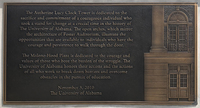 The Autherine Lucy Clock Tower and Malone-Hood Plaza
The Autherine Lucy Clock Tower and Malone-Hood Plaza The Autherine Lucy Clock Tower is dedicated to the sacrifice and commitment of a courageous individual who took a stand for change at a crucial time in the history of The University of Alabama. The open arches, which mirror the architecture of Foster Auditorium, illustrate the opportunities that are available to individuals who have the courage and persistence to walk through the door.
The Malone-Hood Plaza is dedicated to the courage and values of those who bore the burden of the struggle. The University of Alabama honors their actions and the actions of all who work to break down barriers and overcome obstacles in the pursuit of education.
November 3, 2010
The University of Alabama
-
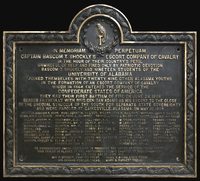 Shockly's Escort Company of Cavalry plaque [removed]
Shockly's Escort Company of Cavalry plaque [removed] In memoriam perpetuam
Captain Bascom T. Shockly’s escort company of cavalry in the hour of their country’s peril unmindful of self and fired only by patriotic devotion Bascom T. Shockly and nineteen students of the University of Alabama joined themselves with twenty nine other Alabama youths in the formation of an escort company of cavalry which in 1864 entered the service of the Confederate States of America.
They had their first baptism of fire on June 24, 1864 served faithfully with Brig. Gen. Dan Adams as his escort to the close of the unequal struggle of the South for separate state sovereignty and were paroled at Gainesville, Alabama, on May 10, 1865.
Shockly, Bascom T., Capt.; Burt, Henry M. 1st Lieut., Miller, John H., 2nd Lieut.; Watkins, John P., 3rd Lieut.
Webb, Wm. T., 1st Sergt.; Cowin, Thos. E., 2nd Sergt; Driskell, Thos. J., 3rd Sergt.; Scott, David M.C., 4th Sergt.
Allen, Joseph M.; Chadwich, E. S.; Galloway, A. G. McGraw, Waters; Rosser, Henry
Archer, Chas. S.; Christian, Wm. C.; Gilmer, Morgan S.; McLemore, Moses; Sawyer, Thos.
Barker, Chas. L.; Clopton, Wm. H.; Hale, C. H.; Moore, Wm. W.; Stoddard, J. Thos.
Bean, Jas.; Collins, J. W.; Harris, Bayless E.; Patton, Robert W.; Stroud, Alonzo B.
Bender, D. Jule; Conner, Junius K.; Harris, Jas. M.; Perkins, J. Hampden; Syring, Frank P.
Billbry, Geo. W.; Crum, Aug. W.; Harrison, Jas. T.; Pittman, Jas. F.; Watt, Jas. H.
Calloway, Darby M.; Crusoe, Chas. W.; Jones, Wm. Clarence; Pitts, P. Henry; Weathers, Wm.; Carson, Shelby C.; Elgin, Rich’d P.; Lewis, Wm. T.; Rivers, Wm. Jones; Webb, Lucius D.
Frazer, Nathan H.; Robertson, Wm. J.
To commemorate these facts and to preserve the names of these young heroes this tablet is placed by the Montgomery County Chapter of Yallerhammers the third day of June 1914
May F. Steiner, Chapter Prest.; Annie H. Spann, State Prest.
Wm. Gerard Fowler, Treas.; Mary G. Burnett, Treas.
-
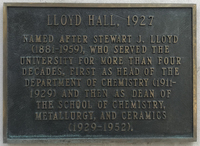 Lloyd Hall, 1927
Lloyd Hall, 1927 Named after Stewart J. Lloyd (1881-1959), who served the University for more than four decades, first as Head of the Department of Chemistry (1911-1929) and then as Dean of the School of Chemistry, Metallurgy, and Ceramics (1929-1952).
-
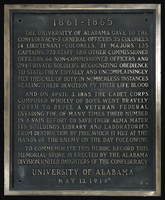 Civil War memorial plaque [removed]
Civil War memorial plaque [removed] 1861-1865
The University of Alabama gave to the Confederacy - 7 General Officers, 25 Colonels, 14 Lieutenant - Colonels, 21 Majors, 125 Captains, 273 Staff and other commissioned officers, 66 Non-Commissioned Officers and 294 Private Soldiers. Recognizing obedience to state, they loyally and uncomplainingly met the call of duty, in numberless instances sealing their devotion by their life blood.
And on April 3, 1865, the Cadet Corps, composed wholly of boys, went bravely forth to repel a veteran Federal invading foe, of many times their number, in a vain effort to save their Alma Mater, its buildings, library and laboratories from destruction by fire, which it met at the hands of the enemy on the day following.
To Commemorate this heroic record this memorial stone is erected by the Alabama Division, United Daughters of the Confederacy. University of Alabama May 13, 1914
-
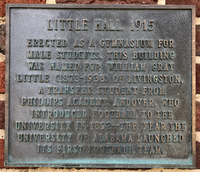 Little Hall, 1915
Little Hall, 1915 Erected as a gymnasium for male students, this building was named for WIlliam Gray Little (1873-1938) of Livingston, a transfer student from Phillips Academy, Andover, who introduced football to the University in 1892 — the year the University of Alabama launched its first football team.
-
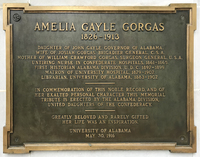 Amelia Gayle Gorgas
1826-1913
Amelia Gayle Gorgas
1826-1913 Daughter of John Gayle, Governor of Alabama. Wife of Josiah Gorgas, Brigadier General, C. S. A.
Mother of William Crawford Gorgas, Surgeon General, U. S. A.
Untiring nurse in Confederate Hospitals, 1861-1865.
First Historian Alabama Division, U. D. C. 1897-1899.
Matron of University Hospital, 1879-1907.
Librarian, University of Alabama, 1883-1907.
In commemoration of this noble record, and of her exalted personal character, this memorial tribute is erected by the Alabama Division, United Daughters of the Confederacy.
Greatly beloved and rarely gifted her life was an inspiration.
University of Alabama
May 30, 1916
-
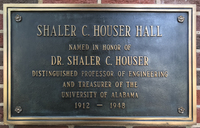 Shaler C. Houser Hall
Shaler C. Houser Hall Named in honor of
Dr. Shaler C. Houser
Distinguished Professor of Engineering
and Treasurer of the
University of Alabama
1912-1948
-
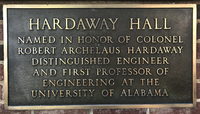 Hardaway Hall
Hardaway Hall Named in honor of Colonel Robert Archelaus Hardaway distinguished engineer and first Professor of Engineering at the University of Alabama
-
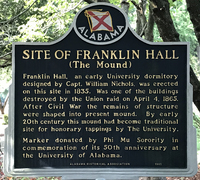 Site of Franklin Hall
(The Mound)
Site of Franklin Hall
(The Mound) Franklin Hall, an early University dormitory designed by Capt. William Nichols, was erected on this site in 1835. Was one of the buildings destroyed by the Union raid on April 4, 1865. After Civil War the remains of structure were shaped into present mound. By early 20th century this mound had become traditional site for honorary tappings by The University.
Marker donated by Phi Mu Sorority in commemoration of its 50th anniversary at the University of Alabama.
-
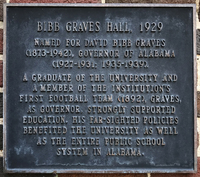 Bibb Graves Hall, 1929 [removed]
Bibb Graves Hall, 1929 [removed] Named for David Bibb Graves (1873-1942), Governor of Alabama (1927-1931, 1935-1939)
A graduate of the University and a member of the institution's first football team (1892), Graves, as governor, strongly supported education. His far-sighted policies benefited the University as well as the entire public school system in Alabama.
-
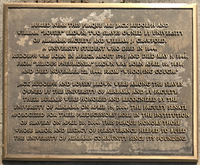 Slave cemetery plaque
Slave cemetery plaque Buried near this plaque are Jack Rudolph and William “Boysey” Brown, two slaves owned by University of Alabama faculty, and William J. Crawford, a University student who died in 1844.
Rudolph was born in Africa about 1791 and died May 5, 1846, from “Bilious Pneumonia.” Brown was born April 10, 1838, and died November 22, 1844, from “Whooping Cough.”
Jack Rudolph and Boysey Brown were among the slaves owned by the University of Alabama and by faculty. Their burials were honored and recognized by the University of Alabama on April 15, 2004. The Faculty Senate apologized for their predecessors’ role in the institution of slavery on April 20, 2004. This plaque honors those whose labor and legacy of perseverance helped to build the University of Alabama Community since its founding.
-
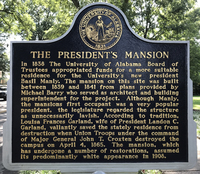 The President's Mansion
The President's Mansion In 1838 The University of Alabama Board of Trustees appropriated funds for a more suitable residence for the University's new president Basil Manly. The mansion on this site was built between 1839 and 1841 from plans provided by Michael Barry who served as architect and building superintendent for the project. Although Manly, the mansions first occupant was a very popular president, the legislature regarded the structure as unnecessarily lavish. According to tradition, Louisa Frances Garland, wife of President Landon C. Garland, valiantly saved the stately residence from destruction when Union Troops under the command of Major General John T. Croxten destroyed the campus on April 4, 1865. The mansion, which has undergone a number of restorations assumed its predominantly white appearance in 1908.
-
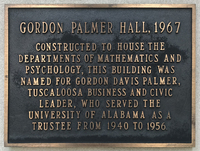 Gordon Palmer Hall, 1967
Gordon Palmer Hall, 1967 Constructed to house the Departments of Mathematics and Psychology, this building was named for Gordon Davis Palmer, Tuscaloosa business and civic leader, who served the University of Alabama as a Trustee from 1940 to 1956.
 Smith Hall, 1908 Named for Eugene Allen Smith (1841-1927), University Professor and State Geologist, who served the State in this dual capacity for fifty-four years. Smith rebuilt the collections of the Alabama Museum of Natural History, which had been destroyed by Federal Troops in 1865. As State Geologist he made an unparalleled contribution to knowledge of the State's mineral resources.
Smith Hall, 1908 Named for Eugene Allen Smith (1841-1927), University Professor and State Geologist, who served the State in this dual capacity for fifty-four years. Smith rebuilt the collections of the Alabama Museum of Natural History, which had been destroyed by Federal Troops in 1865. As State Geologist he made an unparalleled contribution to knowledge of the State's mineral resources. Rowand and Johnson Hall, 1956 Erected to house the Departments of Music and Speech, the building was named in 1994 in honor of Wilbur. H. Rowand, Chairman of the Music Department (1956-1971), who helped bring the department into national prominence, and T. Early Johnson, who founded the Speech Department in 1931 and served as a member of the University Faculty from 1928 to 1969.
Rowand and Johnson Hall, 1956 Erected to house the Departments of Music and Speech, the building was named in 1994 in honor of Wilbur. H. Rowand, Chairman of the Music Department (1956-1971), who helped bring the department into national prominence, and T. Early Johnson, who founded the Speech Department in 1931 and served as a member of the University Faculty from 1928 to 1969. Rose Administration Frank Anthony Rose Hall Named in honor of Frank Anthony Rose, B. D., LLD; Litt. D, LHD President, The University of Alabama 1957-1969 By resolution of the Board of Trustees of The University of Alabama on April 21, 1969 and subsequently authorized by the state legislature of Alabama
Rose Administration Frank Anthony Rose Hall Named in honor of Frank Anthony Rose, B. D., LLD; Litt. D, LHD President, The University of Alabama 1957-1969 By resolution of the Board of Trustees of The University of Alabama on April 21, 1969 and subsequently authorized by the state legislature of Alabama Reese Phifer Hall, 1930 Originally erected as the Alabama Student Union building, this edifice was renovated for use by the College of Communication in 1980 and named in honor of J. Reese Phifer in 1991. Phifer, a Tuscaloosa businessman and philanthropist, and a graduate of the University of Alabama, was unfailingly generous to his alma mater.
Reese Phifer Hall, 1930 Originally erected as the Alabama Student Union building, this edifice was renovated for use by the College of Communication in 1980 and named in honor of J. Reese Phifer in 1991. Phifer, a Tuscaloosa businessman and philanthropist, and a graduate of the University of Alabama, was unfailingly generous to his alma mater. Oliver-Barnard Hall College of Arts and Sciences Erected: 1889 Reconstructed: 2000 Named for professor, scientist, and photographer F.A.P. Barnard who pioneered the study of astronomy at The University of Alabama and established its chapter of Phi Beta Kappa in 1851. On August 26, 2000, rededicated Oliver-Barnard Hall in honor of alumni and friend John T. Oliver Jr., trustee of The University of Alabama, and established as a Blount Undergraduate Initiative Academic House. During his 28 years on the Board of Trustees (1971-1999), Oliver played a key role in the selection of four chancellors of The University of Alabama System, three University presidents, and seven presidents at sister institutions in Birmingham and Huntsville. Contractor: N.C. Morgan Construction Co. Architect: Barganier Davis Sims
Oliver-Barnard Hall College of Arts and Sciences Erected: 1889 Reconstructed: 2000 Named for professor, scientist, and photographer F.A.P. Barnard who pioneered the study of astronomy at The University of Alabama and established its chapter of Phi Beta Kappa in 1851. On August 26, 2000, rededicated Oliver-Barnard Hall in honor of alumni and friend John T. Oliver Jr., trustee of The University of Alabama, and established as a Blount Undergraduate Initiative Academic House. During his 28 years on the Board of Trustees (1971-1999), Oliver played a key role in the selection of four chancellors of The University of Alabama System, three University presidents, and seven presidents at sister institutions in Birmingham and Huntsville. Contractor: N.C. Morgan Construction Co. Architect: Barganier Davis Sims Nott Hall, 1922 [removed] Named for Josiah Clarke Nott, M.D. (1804-1873), who founded the University's first medical school in Mobile in 1859. When the Mobile school was discontinued in 1920, the Trustees opened a new two-year medical program in this building on the Tuscaloosa campus. In 1945 the Medical School was moved to Birmingham and expanded to create a full School of Medicine.
Nott Hall, 1922 [removed] Named for Josiah Clarke Nott, M.D. (1804-1873), who founded the University's first medical school in Mobile in 1859. When the Mobile school was discontinued in 1920, the Trustees opened a new two-year medical program in this building on the Tuscaloosa campus. In 1945 the Medical School was moved to Birmingham and expanded to create a full School of Medicine. Morgan Hall, 1910 [removed] Named for John Tyler Morgan (1824-1907). As U.S. Senator, Morgan led the 1882 campaign to obtain federal funds in reparation for the destruction of the University of Alabama campus by Union Troops in 1865. A member of the Alabama Secession Convention and a Brigadier General in the Confederate Army, Morgan was later (1876) elected to the U.S. Senate, where he became known as "Canal Morgan" for his strong support of a canal across Central America.
Morgan Hall, 1910 [removed] Named for John Tyler Morgan (1824-1907). As U.S. Senator, Morgan led the 1882 campaign to obtain federal funds in reparation for the destruction of the University of Alabama campus by Union Troops in 1865. A member of the Alabama Secession Convention and a Brigadier General in the Confederate Army, Morgan was later (1876) elected to the U.S. Senate, where he became known as "Canal Morgan" for his strong support of a canal across Central America. A.B. Moore Hall [removed] Named in honor of Albert Burton Moore Chairman - History Department 1923-1951 First Dean of the Graduate School 1925-1958 Chairman - Athletic Committee 1941-1958 President - National Collegiate Athletic Association 1951-1952 President - Alabama Historical Association 1951-1952 President - Southern Historical Association 1942 President - Conference of Southern Deans 1938
A.B. Moore Hall [removed] Named in honor of Albert Burton Moore Chairman - History Department 1923-1951 First Dean of the Graduate School 1925-1958 Chairman - Athletic Committee 1941-1958 President - National Collegiate Athletic Association 1951-1952 President - Alabama Historical Association 1951-1952 President - Southern Historical Association 1942 President - Conference of Southern Deans 1938 Vivian Malone stepped through the schoolhouse door on June 11, 1963. She became the University’s first African-American graduate on May 30, 1965, when she received a B.S. in Commerce and Business Administration. She received an Honorary Doctor of Humane Letters on August 12, 2000. Her sacrifice, courage and commitment to simple justice guaranteed educational opportunities for all students. "There will come a day in your life when you must act for others… and you must be ready. You must be bold, have courage and walk through a door that leads to opportunity for others.” Vivian Malone
Vivian Malone stepped through the schoolhouse door on June 11, 1963. She became the University’s first African-American graduate on May 30, 1965, when she received a B.S. in Commerce and Business Administration. She received an Honorary Doctor of Humane Letters on August 12, 2000. Her sacrifice, courage and commitment to simple justice guaranteed educational opportunities for all students. "There will come a day in your life when you must act for others… and you must be ready. You must be bold, have courage and walk through a door that leads to opportunity for others.” Vivian Malone Autherine Lucy became the first African-American student to enroll in The University of Alabama on February 3, 1956. Because of significant unrest on campus, her initial enrollment lasted only three days. She returned to the University in the 1980s, and earned a master’s degree in education on August 17, 1991. She is an enduring symbol of what one person acting with courage and commitment can accomplish. “My response to fear is: do it anyway. Let nothing stop you. You have to push forward.” Autherine Lucy
Autherine Lucy became the first African-American student to enroll in The University of Alabama on February 3, 1956. Because of significant unrest on campus, her initial enrollment lasted only three days. She returned to the University in the 1980s, and earned a master’s degree in education on August 17, 1991. She is an enduring symbol of what one person acting with courage and commitment can accomplish. “My response to fear is: do it anyway. Let nothing stop you. You have to push forward.” Autherine Lucy Storrs Cadet Troop [removed] Pro Virtute Et Patria Capt. Charles P. Storrs cadet troop, Company F, 7th Alabama Cavalry Regiment, C.S.A.,organized in June 1863 under the leadership of Cadet Capt. Storrs, made up of cadets from The University of Alabama and of patriotic young men from Montgomery and vicinity; united with 7th Ala. Cav. Regt. as Co. F, July 22, 1863. First stationed at Pollard and Mobile for coast defense, 1863-1864; in Oct. 1864 transferred to command of Gen. Nathan Bedford Forrest, Army of Tennessee, and assigned to Gen. E. W. Rucker as escort, serving as such until that gallant officer was wounded in Dec. 1864; engaged at Johnsonville, Henryville, Mt. Pleasant, Columbia, Spring Hill, Franklin and Nashville, 1864; aided in resisting the federal invasion of Alabama; participated at Columbus, Ga., in the last battle of the war, April 16, 1865; and laid down its arms at Gainesville, Ala., May 14, 1865. “The unconquerable tenacity, the brilliant valor of these boys, who faced and fought all odds, until their ranks were cut to pieces, excited general notice and praise.” – Jordan’s Campaigns of Forrest, 1868 Roster – Officers Captain Charles Paddock Storrs+, 1st Lieut. Henry Clay Vaughan+, 2nd Lieut. Benjamin Fitzpatrick+ Jr. 2nd Lieuts. Francis Drayton Nabers+, James A. Craig+ Sergeants Wm. Bell Whiting+, W. D. Hatch+, R. B. Waller+, W. H. Locke+, J. G. Winter+, Q.M. Sergt. H. S. McGowen+ Corporals R. H. Jackson+, Wm. A. Walker+, C. P. Field+, R. H. Evins+, Napoleon Lockett+, Thomas Hudson Privates Adams, W. H.; Davidson, George; Griffin, Goodman G.+; Lowe, George J.; Smith, B. Alford, Julius S.+; Douglas, Wm.+; Hails, George W.; McAdory, R. A.+; Smith, George Anderson, L.; Driesbach, Tate R.+; Hart, John S.+; McMillan, J. D.+; Taylor, W. K. Barnett, Joel; Elmore, Rush; Hartwell, Charles; Marks, Samuel B.+; Thorington, Jack Bethea, A. Jack; Evins, A. J.; Hatch, Ben F.+; Metcalf, John; Trimble, W. Ross+ Bolling, T. C.; Farley, James H.+; Hatch, Drew; Miller, A. A.+; Tyson, A. P.+ Boyd, Joe J.; Farrar, H. K.; High, De Witt C.+; Mitchell, C. White; Underwood, J. B. Brittan, Henry S.; Fletcher, Matt; Hogue, John J.; Moore, A. B.; Vaughan, Joseph L. Caffey, Wm. Hooper+; Fletcher, Wm.; Hooper, Wm. De B.; Moore, W. J.; Vernon, James B.+ Campbell, Archibald+; Forniss, John A.; Howard, Mark+; Morrison, W. J.; Walker, W. T. Cantalou, John R.+; Foster, Young H.+; Hudson, Joseph; Morrow, George M.; Ware, A. S. Clarke, Thomas D.+; Goldthwaite, George+; Hudson, Wm. H.; Myers, Laurens O’B.+; Ware, J. E. Corey; Graham, George L.; Janney, Wm. Brown; Pitts, Thomas; Watts, John W.+ Cox, Jesse J.+; Graves, E. Dedrick+; James, E. Lindsey; Pollard, John S.; Webb, Edward Craig, Drew; Greenwood, John C.+; Jones, T. K.+; Sayre, W. D.; Westcott, Samuel T.+ Dargan, Moro+; Gregory, Fred C., Jr.+; Joseph, Leonce; Shelby, Duncan; Woodfin, Arthur Long, W. Hal +Cadet, U. of A Placed by survivors and friends in honor of the devoted service, signal valor and noble record of this company, University of Alabama, May 30, 1916
Storrs Cadet Troop [removed] Pro Virtute Et Patria Capt. Charles P. Storrs cadet troop, Company F, 7th Alabama Cavalry Regiment, C.S.A.,organized in June 1863 under the leadership of Cadet Capt. Storrs, made up of cadets from The University of Alabama and of patriotic young men from Montgomery and vicinity; united with 7th Ala. Cav. Regt. as Co. F, July 22, 1863. First stationed at Pollard and Mobile for coast defense, 1863-1864; in Oct. 1864 transferred to command of Gen. Nathan Bedford Forrest, Army of Tennessee, and assigned to Gen. E. W. Rucker as escort, serving as such until that gallant officer was wounded in Dec. 1864; engaged at Johnsonville, Henryville, Mt. Pleasant, Columbia, Spring Hill, Franklin and Nashville, 1864; aided in resisting the federal invasion of Alabama; participated at Columbus, Ga., in the last battle of the war, April 16, 1865; and laid down its arms at Gainesville, Ala., May 14, 1865. “The unconquerable tenacity, the brilliant valor of these boys, who faced and fought all odds, until their ranks were cut to pieces, excited general notice and praise.” – Jordan’s Campaigns of Forrest, 1868 Roster – Officers Captain Charles Paddock Storrs+, 1st Lieut. Henry Clay Vaughan+, 2nd Lieut. Benjamin Fitzpatrick+ Jr. 2nd Lieuts. Francis Drayton Nabers+, James A. Craig+ Sergeants Wm. Bell Whiting+, W. D. Hatch+, R. B. Waller+, W. H. Locke+, J. G. Winter+, Q.M. Sergt. H. S. McGowen+ Corporals R. H. Jackson+, Wm. A. Walker+, C. P. Field+, R. H. Evins+, Napoleon Lockett+, Thomas Hudson Privates Adams, W. H.; Davidson, George; Griffin, Goodman G.+; Lowe, George J.; Smith, B. Alford, Julius S.+; Douglas, Wm.+; Hails, George W.; McAdory, R. A.+; Smith, George Anderson, L.; Driesbach, Tate R.+; Hart, John S.+; McMillan, J. D.+; Taylor, W. K. Barnett, Joel; Elmore, Rush; Hartwell, Charles; Marks, Samuel B.+; Thorington, Jack Bethea, A. Jack; Evins, A. J.; Hatch, Ben F.+; Metcalf, John; Trimble, W. Ross+ Bolling, T. C.; Farley, James H.+; Hatch, Drew; Miller, A. A.+; Tyson, A. P.+ Boyd, Joe J.; Farrar, H. K.; High, De Witt C.+; Mitchell, C. White; Underwood, J. B. Brittan, Henry S.; Fletcher, Matt; Hogue, John J.; Moore, A. B.; Vaughan, Joseph L. Caffey, Wm. Hooper+; Fletcher, Wm.; Hooper, Wm. De B.; Moore, W. J.; Vernon, James B.+ Campbell, Archibald+; Forniss, John A.; Howard, Mark+; Morrison, W. J.; Walker, W. T. Cantalou, John R.+; Foster, Young H.+; Hudson, Joseph; Morrow, George M.; Ware, A. S. Clarke, Thomas D.+; Goldthwaite, George+; Hudson, Wm. H.; Myers, Laurens O’B.+; Ware, J. E. Corey; Graham, George L.; Janney, Wm. Brown; Pitts, Thomas; Watts, John W.+ Cox, Jesse J.+; Graves, E. Dedrick+; James, E. Lindsey; Pollard, John S.; Webb, Edward Craig, Drew; Greenwood, John C.+; Jones, T. K.+; Sayre, W. D.; Westcott, Samuel T.+ Dargan, Moro+; Gregory, Fred C., Jr.+; Joseph, Leonce; Shelby, Duncan; Woodfin, Arthur Long, W. Hal +Cadet, U. of A Placed by survivors and friends in honor of the devoted service, signal valor and noble record of this company, University of Alabama, May 30, 1916 James Hood officially desegregated The University of Alabama on June 11, 1963, when he walked into Foster Auditorium to enroll in classes. While he left the University before completing his undergraduate degree, he returned to campus and earned a Ph.D. in interdisciplinary studies on May 17, 1997. Because he believed in himself and in the power of his dreams, he opened the doors of opportunity for others. “One person can make a difference if that one person is committed to making a difference.” James Hood
James Hood officially desegregated The University of Alabama on June 11, 1963, when he walked into Foster Auditorium to enroll in classes. While he left the University before completing his undergraduate degree, he returned to campus and earned a Ph.D. in interdisciplinary studies on May 17, 1997. Because he believed in himself and in the power of his dreams, he opened the doors of opportunity for others. “One person can make a difference if that one person is committed to making a difference.” James Hood The Autherine Lucy Clock Tower and Malone-Hood Plaza The Autherine Lucy Clock Tower is dedicated to the sacrifice and commitment of a courageous individual who took a stand for change at a crucial time in the history of The University of Alabama. The open arches, which mirror the architecture of Foster Auditorium, illustrate the opportunities that are available to individuals who have the courage and persistence to walk through the door. The Malone-Hood Plaza is dedicated to the courage and values of those who bore the burden of the struggle. The University of Alabama honors their actions and the actions of all who work to break down barriers and overcome obstacles in the pursuit of education. November 3, 2010 The University of Alabama
The Autherine Lucy Clock Tower and Malone-Hood Plaza The Autherine Lucy Clock Tower is dedicated to the sacrifice and commitment of a courageous individual who took a stand for change at a crucial time in the history of The University of Alabama. The open arches, which mirror the architecture of Foster Auditorium, illustrate the opportunities that are available to individuals who have the courage and persistence to walk through the door. The Malone-Hood Plaza is dedicated to the courage and values of those who bore the burden of the struggle. The University of Alabama honors their actions and the actions of all who work to break down barriers and overcome obstacles in the pursuit of education. November 3, 2010 The University of Alabama Shockly's Escort Company of Cavalry plaque [removed] In memoriam perpetuam Captain Bascom T. Shockly’s escort company of cavalry in the hour of their country’s peril unmindful of self and fired only by patriotic devotion Bascom T. Shockly and nineteen students of the University of Alabama joined themselves with twenty nine other Alabama youths in the formation of an escort company of cavalry which in 1864 entered the service of the Confederate States of America. They had their first baptism of fire on June 24, 1864 served faithfully with Brig. Gen. Dan Adams as his escort to the close of the unequal struggle of the South for separate state sovereignty and were paroled at Gainesville, Alabama, on May 10, 1865. Shockly, Bascom T., Capt.; Burt, Henry M. 1st Lieut., Miller, John H., 2nd Lieut.; Watkins, John P., 3rd Lieut. Webb, Wm. T., 1st Sergt.; Cowin, Thos. E., 2nd Sergt; Driskell, Thos. J., 3rd Sergt.; Scott, David M.C., 4th Sergt. Allen, Joseph M.; Chadwich, E. S.; Galloway, A. G. McGraw, Waters; Rosser, Henry Archer, Chas. S.; Christian, Wm. C.; Gilmer, Morgan S.; McLemore, Moses; Sawyer, Thos. Barker, Chas. L.; Clopton, Wm. H.; Hale, C. H.; Moore, Wm. W.; Stoddard, J. Thos. Bean, Jas.; Collins, J. W.; Harris, Bayless E.; Patton, Robert W.; Stroud, Alonzo B. Bender, D. Jule; Conner, Junius K.; Harris, Jas. M.; Perkins, J. Hampden; Syring, Frank P. Billbry, Geo. W.; Crum, Aug. W.; Harrison, Jas. T.; Pittman, Jas. F.; Watt, Jas. H. Calloway, Darby M.; Crusoe, Chas. W.; Jones, Wm. Clarence; Pitts, P. Henry; Weathers, Wm.; Carson, Shelby C.; Elgin, Rich’d P.; Lewis, Wm. T.; Rivers, Wm. Jones; Webb, Lucius D. Frazer, Nathan H.; Robertson, Wm. J. To commemorate these facts and to preserve the names of these young heroes this tablet is placed by the Montgomery County Chapter of Yallerhammers the third day of June 1914 May F. Steiner, Chapter Prest.; Annie H. Spann, State Prest. Wm. Gerard Fowler, Treas.; Mary G. Burnett, Treas.
Shockly's Escort Company of Cavalry plaque [removed] In memoriam perpetuam Captain Bascom T. Shockly’s escort company of cavalry in the hour of their country’s peril unmindful of self and fired only by patriotic devotion Bascom T. Shockly and nineteen students of the University of Alabama joined themselves with twenty nine other Alabama youths in the formation of an escort company of cavalry which in 1864 entered the service of the Confederate States of America. They had their first baptism of fire on June 24, 1864 served faithfully with Brig. Gen. Dan Adams as his escort to the close of the unequal struggle of the South for separate state sovereignty and were paroled at Gainesville, Alabama, on May 10, 1865. Shockly, Bascom T., Capt.; Burt, Henry M. 1st Lieut., Miller, John H., 2nd Lieut.; Watkins, John P., 3rd Lieut. Webb, Wm. T., 1st Sergt.; Cowin, Thos. E., 2nd Sergt; Driskell, Thos. J., 3rd Sergt.; Scott, David M.C., 4th Sergt. Allen, Joseph M.; Chadwich, E. S.; Galloway, A. G. McGraw, Waters; Rosser, Henry Archer, Chas. S.; Christian, Wm. C.; Gilmer, Morgan S.; McLemore, Moses; Sawyer, Thos. Barker, Chas. L.; Clopton, Wm. H.; Hale, C. H.; Moore, Wm. W.; Stoddard, J. Thos. Bean, Jas.; Collins, J. W.; Harris, Bayless E.; Patton, Robert W.; Stroud, Alonzo B. Bender, D. Jule; Conner, Junius K.; Harris, Jas. M.; Perkins, J. Hampden; Syring, Frank P. Billbry, Geo. W.; Crum, Aug. W.; Harrison, Jas. T.; Pittman, Jas. F.; Watt, Jas. H. Calloway, Darby M.; Crusoe, Chas. W.; Jones, Wm. Clarence; Pitts, P. Henry; Weathers, Wm.; Carson, Shelby C.; Elgin, Rich’d P.; Lewis, Wm. T.; Rivers, Wm. Jones; Webb, Lucius D. Frazer, Nathan H.; Robertson, Wm. J. To commemorate these facts and to preserve the names of these young heroes this tablet is placed by the Montgomery County Chapter of Yallerhammers the third day of June 1914 May F. Steiner, Chapter Prest.; Annie H. Spann, State Prest. Wm. Gerard Fowler, Treas.; Mary G. Burnett, Treas. Lloyd Hall, 1927 Named after Stewart J. Lloyd (1881-1959), who served the University for more than four decades, first as Head of the Department of Chemistry (1911-1929) and then as Dean of the School of Chemistry, Metallurgy, and Ceramics (1929-1952).
Lloyd Hall, 1927 Named after Stewart J. Lloyd (1881-1959), who served the University for more than four decades, first as Head of the Department of Chemistry (1911-1929) and then as Dean of the School of Chemistry, Metallurgy, and Ceramics (1929-1952). Civil War memorial plaque [removed] 1861-1865 The University of Alabama gave to the Confederacy - 7 General Officers, 25 Colonels, 14 Lieutenant - Colonels, 21 Majors, 125 Captains, 273 Staff and other commissioned officers, 66 Non-Commissioned Officers and 294 Private Soldiers. Recognizing obedience to state, they loyally and uncomplainingly met the call of duty, in numberless instances sealing their devotion by their life blood. And on April 3, 1865, the Cadet Corps, composed wholly of boys, went bravely forth to repel a veteran Federal invading foe, of many times their number, in a vain effort to save their Alma Mater, its buildings, library and laboratories from destruction by fire, which it met at the hands of the enemy on the day following. To Commemorate this heroic record this memorial stone is erected by the Alabama Division, United Daughters of the Confederacy. University of Alabama May 13, 1914
Civil War memorial plaque [removed] 1861-1865 The University of Alabama gave to the Confederacy - 7 General Officers, 25 Colonels, 14 Lieutenant - Colonels, 21 Majors, 125 Captains, 273 Staff and other commissioned officers, 66 Non-Commissioned Officers and 294 Private Soldiers. Recognizing obedience to state, they loyally and uncomplainingly met the call of duty, in numberless instances sealing their devotion by their life blood. And on April 3, 1865, the Cadet Corps, composed wholly of boys, went bravely forth to repel a veteran Federal invading foe, of many times their number, in a vain effort to save their Alma Mater, its buildings, library and laboratories from destruction by fire, which it met at the hands of the enemy on the day following. To Commemorate this heroic record this memorial stone is erected by the Alabama Division, United Daughters of the Confederacy. University of Alabama May 13, 1914 Little Hall, 1915 Erected as a gymnasium for male students, this building was named for WIlliam Gray Little (1873-1938) of Livingston, a transfer student from Phillips Academy, Andover, who introduced football to the University in 1892 — the year the University of Alabama launched its first football team.
Little Hall, 1915 Erected as a gymnasium for male students, this building was named for WIlliam Gray Little (1873-1938) of Livingston, a transfer student from Phillips Academy, Andover, who introduced football to the University in 1892 — the year the University of Alabama launched its first football team. Amelia Gayle Gorgas
1826-1913 Daughter of John Gayle, Governor of Alabama. Wife of Josiah Gorgas, Brigadier General, C. S. A. Mother of William Crawford Gorgas, Surgeon General, U. S. A. Untiring nurse in Confederate Hospitals, 1861-1865. First Historian Alabama Division, U. D. C. 1897-1899. Matron of University Hospital, 1879-1907. Librarian, University of Alabama, 1883-1907. In commemoration of this noble record, and of her exalted personal character, this memorial tribute is erected by the Alabama Division, United Daughters of the Confederacy. Greatly beloved and rarely gifted her life was an inspiration. University of Alabama May 30, 1916
Amelia Gayle Gorgas
1826-1913 Daughter of John Gayle, Governor of Alabama. Wife of Josiah Gorgas, Brigadier General, C. S. A. Mother of William Crawford Gorgas, Surgeon General, U. S. A. Untiring nurse in Confederate Hospitals, 1861-1865. First Historian Alabama Division, U. D. C. 1897-1899. Matron of University Hospital, 1879-1907. Librarian, University of Alabama, 1883-1907. In commemoration of this noble record, and of her exalted personal character, this memorial tribute is erected by the Alabama Division, United Daughters of the Confederacy. Greatly beloved and rarely gifted her life was an inspiration. University of Alabama May 30, 1916 Shaler C. Houser Hall Named in honor of Dr. Shaler C. Houser Distinguished Professor of Engineering and Treasurer of the University of Alabama 1912-1948
Shaler C. Houser Hall Named in honor of Dr. Shaler C. Houser Distinguished Professor of Engineering and Treasurer of the University of Alabama 1912-1948 Hardaway Hall Named in honor of Colonel Robert Archelaus Hardaway distinguished engineer and first Professor of Engineering at the University of Alabama
Hardaway Hall Named in honor of Colonel Robert Archelaus Hardaway distinguished engineer and first Professor of Engineering at the University of Alabama Site of Franklin Hall
(The Mound) Franklin Hall, an early University dormitory designed by Capt. William Nichols, was erected on this site in 1835. Was one of the buildings destroyed by the Union raid on April 4, 1865. After Civil War the remains of structure were shaped into present mound. By early 20th century this mound had become traditional site for honorary tappings by The University. Marker donated by Phi Mu Sorority in commemoration of its 50th anniversary at the University of Alabama.
Site of Franklin Hall
(The Mound) Franklin Hall, an early University dormitory designed by Capt. William Nichols, was erected on this site in 1835. Was one of the buildings destroyed by the Union raid on April 4, 1865. After Civil War the remains of structure were shaped into present mound. By early 20th century this mound had become traditional site for honorary tappings by The University. Marker donated by Phi Mu Sorority in commemoration of its 50th anniversary at the University of Alabama. Bibb Graves Hall, 1929 [removed] Named for David Bibb Graves (1873-1942), Governor of Alabama (1927-1931, 1935-1939) A graduate of the University and a member of the institution's first football team (1892), Graves, as governor, strongly supported education. His far-sighted policies benefited the University as well as the entire public school system in Alabama.
Bibb Graves Hall, 1929 [removed] Named for David Bibb Graves (1873-1942), Governor of Alabama (1927-1931, 1935-1939) A graduate of the University and a member of the institution's first football team (1892), Graves, as governor, strongly supported education. His far-sighted policies benefited the University as well as the entire public school system in Alabama. Slave cemetery plaque Buried near this plaque are Jack Rudolph and William “Boysey” Brown, two slaves owned by University of Alabama faculty, and William J. Crawford, a University student who died in 1844. Rudolph was born in Africa about 1791 and died May 5, 1846, from “Bilious Pneumonia.” Brown was born April 10, 1838, and died November 22, 1844, from “Whooping Cough.” Jack Rudolph and Boysey Brown were among the slaves owned by the University of Alabama and by faculty. Their burials were honored and recognized by the University of Alabama on April 15, 2004. The Faculty Senate apologized for their predecessors’ role in the institution of slavery on April 20, 2004. This plaque honors those whose labor and legacy of perseverance helped to build the University of Alabama Community since its founding.
Slave cemetery plaque Buried near this plaque are Jack Rudolph and William “Boysey” Brown, two slaves owned by University of Alabama faculty, and William J. Crawford, a University student who died in 1844. Rudolph was born in Africa about 1791 and died May 5, 1846, from “Bilious Pneumonia.” Brown was born April 10, 1838, and died November 22, 1844, from “Whooping Cough.” Jack Rudolph and Boysey Brown were among the slaves owned by the University of Alabama and by faculty. Their burials were honored and recognized by the University of Alabama on April 15, 2004. The Faculty Senate apologized for their predecessors’ role in the institution of slavery on April 20, 2004. This plaque honors those whose labor and legacy of perseverance helped to build the University of Alabama Community since its founding. The President's Mansion In 1838 The University of Alabama Board of Trustees appropriated funds for a more suitable residence for the University's new president Basil Manly. The mansion on this site was built between 1839 and 1841 from plans provided by Michael Barry who served as architect and building superintendent for the project. Although Manly, the mansions first occupant was a very popular president, the legislature regarded the structure as unnecessarily lavish. According to tradition, Louisa Frances Garland, wife of President Landon C. Garland, valiantly saved the stately residence from destruction when Union Troops under the command of Major General John T. Croxten destroyed the campus on April 4, 1865. The mansion, which has undergone a number of restorations assumed its predominantly white appearance in 1908.
The President's Mansion In 1838 The University of Alabama Board of Trustees appropriated funds for a more suitable residence for the University's new president Basil Manly. The mansion on this site was built between 1839 and 1841 from plans provided by Michael Barry who served as architect and building superintendent for the project. Although Manly, the mansions first occupant was a very popular president, the legislature regarded the structure as unnecessarily lavish. According to tradition, Louisa Frances Garland, wife of President Landon C. Garland, valiantly saved the stately residence from destruction when Union Troops under the command of Major General John T. Croxten destroyed the campus on April 4, 1865. The mansion, which has undergone a number of restorations assumed its predominantly white appearance in 1908. Gordon Palmer Hall, 1967 Constructed to house the Departments of Mathematics and Psychology, this building was named for Gordon Davis Palmer, Tuscaloosa business and civic leader, who served the University of Alabama as a Trustee from 1940 to 1956.
Gordon Palmer Hall, 1967 Constructed to house the Departments of Mathematics and Psychology, this building was named for Gordon Davis Palmer, Tuscaloosa business and civic leader, who served the University of Alabama as a Trustee from 1940 to 1956.